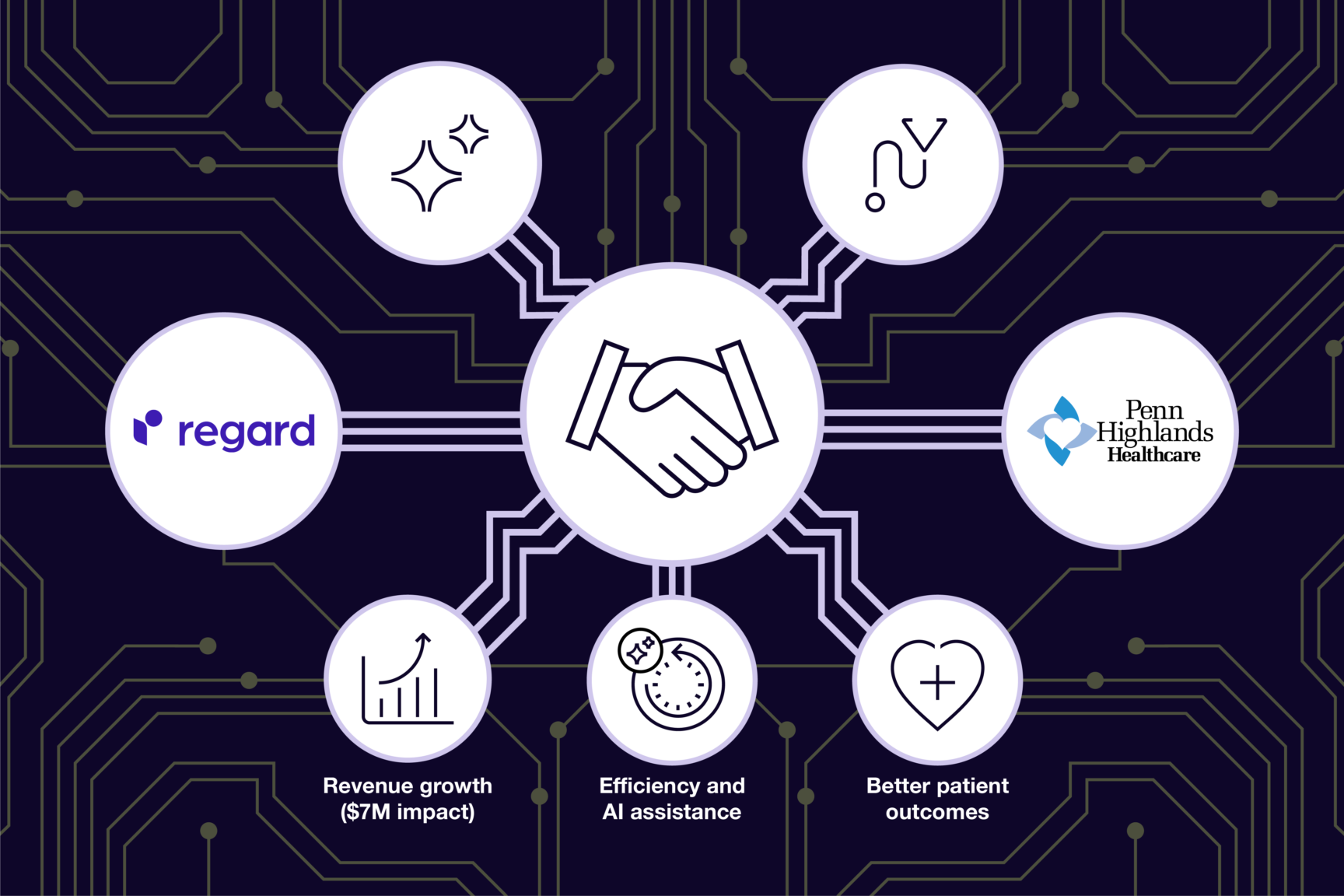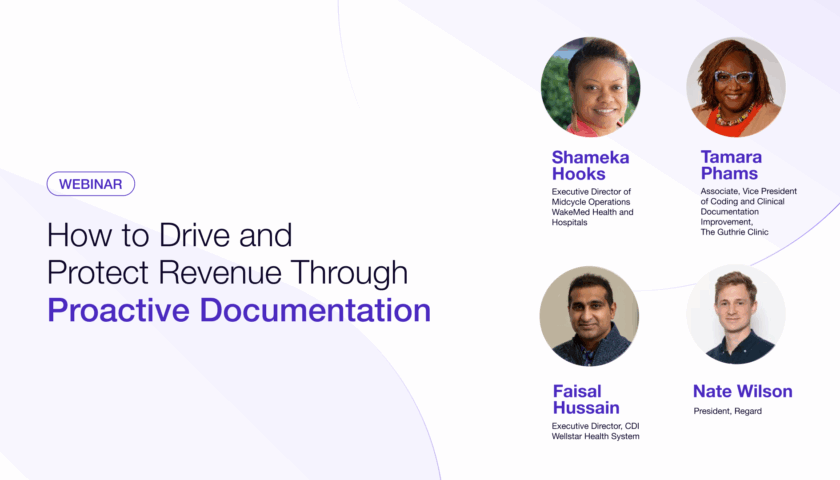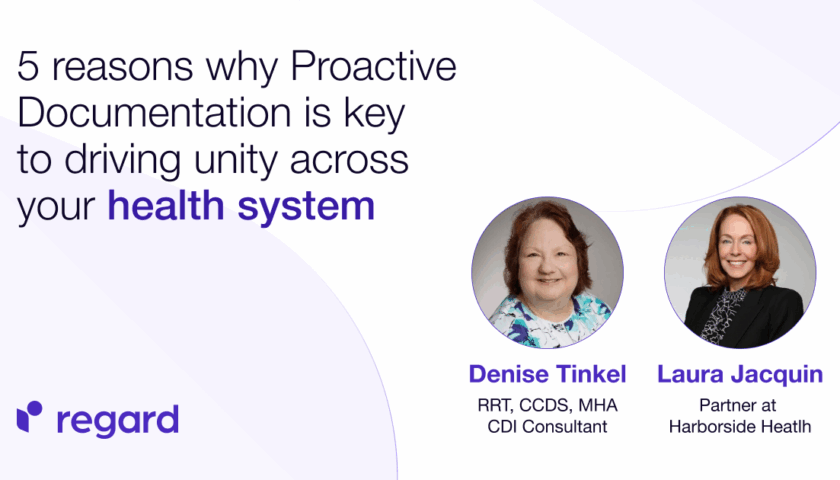
Nate Wilson, cofounder and president of Regard, recently sat down with Russell Cameron, MD, former CMO of Penn Highlands Healthcare, to talk about how the organization leverages Regard, the leading clinical insights platform, to solve some of its most pressing financial and operational challenges.
Their conversation, recorded at the October 2024 HLTH conference in Las Vegas, highlights how hospitals can leverage Regard to increase reimbursement, improve patient safety and quality scores, and promote physician satisfaction.
The backstory
Penn Highlands Healthcare, a 9-hospital system in rural Pennsylvania, wanted to improve its clinical documentation. However, like most health systems, it grappled with physician burnout and didn’t want to intensify the already-profound administrative burden placed on its hard-working clinical teams.
Still, Cameron told attendees during the HLTH conference that he and his colleagues knew that better documentation would improve patient safety and increase reimbursement, the latter of which was critical during the economic downturn of the COVID pandemic.
At that same time, Penn Highlands had recently hired several neurosurgeons and interventional radiologists. Cameron said the increased levels of care these clinicians provided wasn’t going to be enough to sustain the health system financially in the long run. Penn Highlands tried other strategies, too. The health system’s CFO purchased a retrospective clinical documentation improvement (CDI) tool to help capture additional revenue, but the tool didn’t produce a measurable return on investment, it didn’t fit concurrently into clinical workflows.
That’s when the health system started to consider artificial intelligence (AI) solutions to improve documentation on the front end. However, Cameron told HTLTH attendees it was difficult to find an AI solution that checked all the boxes, meaning one that:
- Demonstrated a clear financial return on investment
- Ensured transparency by hyperlinking diagnoses to supportive evidence in the record
- Evolved based on user feedback to ensure physicians got the information they needed and wanted at the point of care
- Integrated into clinical workflows concurrently and with ease
- Required minimal physician training
Connecting with Regard
Regard is the exception because it does check all the boxes, Wilson said during the HLTH presentation. Regard reads the entire chart, surfaces important information at the point of care, and drafts a clinical note on the physician’s behalf using real-time data.
Cameron said he quickly realized Regard’s uniqueness after a five-month pilot program and that the results to date speak for themselves:
- $7 million in additional revenue
- 7% increase in CC/MCC capture
- 10% increase to the case mix index
- 20% average decrease in time spent documenting with some users experiencing a 3–4-hour time savings per day
Key elements of the pilot program?
- Alignment between clinical and financial departments
- Focus on change management
- Onsite one-on-one training for every physician who needed it
After the conclusion of the pilot program, Cameron said Penn Highlands scaled its use of Regard across all hospitals and continues to leverage it in new settings as the health system expands. Currently, 95% of its physicians systemwide use the technology voluntarily.
Fast forward to today
Patient safety was a top priority, and by keeping patients safe with the help of high-quality, well-documented clinical care, Penn Highland’s reimbursement increased. Cameron said Regard continues to help clinicians make smart decisions at the point of care while also ensuring data accurately reflects the severity of illness and risk of mortality that drive publicly reported quality metrics and risk-adjusted payments.
During the HLTH conversation, Cameron recalled a case in which a woman in her 40s presented with a mild stroke. The hospitalist treating this patient had access to 12 years’ worth of data in the electronic health record and looked for any evidence of potential atrial fibrillation so they could develop a treatment plan to prevent a future stroke. However, after reviewing countless inpatient notes, outpatient notes, and cardiology notes, there was no evidence.
Then the hospitals turned on Regard.
Within seconds, Regard identified atrial fibrillation based on an EKG from 10 years ago that had been scanned into the record.
Making a difference one patient at a time
Wilson said he wasn’t surprised because it’s the same story at the additional 150 hospitals in 15 states nationwide that also use Regard. Simply put: Clinicians practice medicine better in less time.
In fact, he said it’s irresponsible for today’s physicians to treat patients without using a clinical insights platform. Why? With 50,000 data points in each patient’s electronic health record, every physician has blind spots. Physicians only have time to review approximately three percent of this data which means 97% goes unseen. When missed, medications, diagnoses, and relevant context pose a risk not only to physicians themselves but also to patients.
However, Wilson reiterated that the goal is also to promote revenue integrity. Regard does this by ensuring organizations catch all relevant diagnoses, add them to the clinical note, and include them on the final bill. Quarterly business reviews help organizations quantify when and how these additional diagnoses increase reimbursement.
It’s a fully transparent process in which clinicians and finance teams are involved for the betterment of patients and the organization.
To see how Regard can work with your health system, schedule a demo today.


